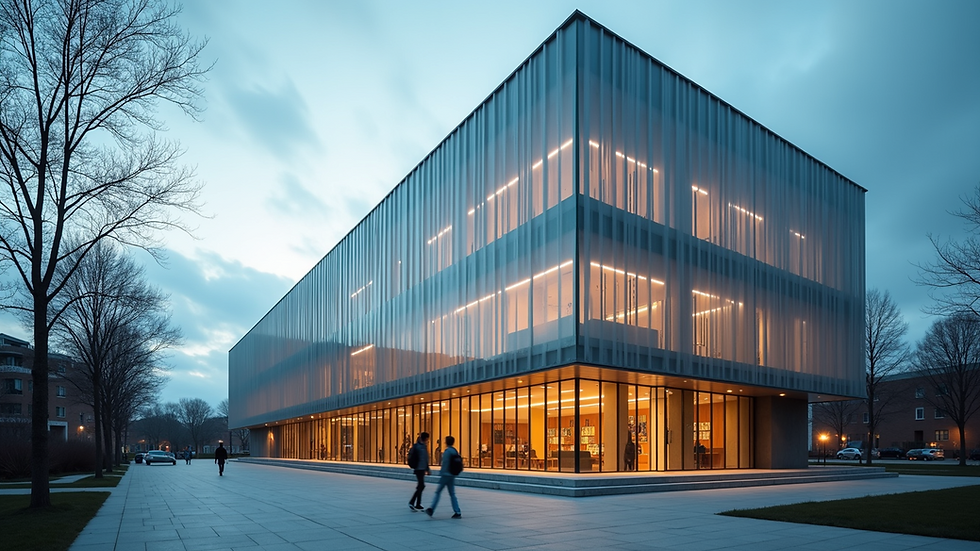Libraries as Urban Oases: Exploring Their Role in Modern City Life
- louai86alsam
- Jul 13
- 4 min read
Libraries in Modern City Life: Designing the Future of Civic Spaces
The only real urban sanctuary in the fast-paced, technologically advanced world of today is the library. They are more than simply book libraries; they are vital civic hubs that welcome everyone from all walks of life, irrespective of their financial situation, age, housing situation, or level of computer proficiency. These inclusive areas serve as models for community-centered design as cities develop, demonstrating the power of architecture and careful placemaking to bridge social gaps and promote civic well-being.
The Role of Libraries in Civic Health and Community Engagement
Because they provide places for people to congregate, learn, and develop trust, libraries are the epitome of civic health. They motivate locals to engage in activities that improve relationships, build social capital, and foster a feeling of community. Libraries are a great example of how locations can promote civic involvement, which is something we frequently highlight in our design and 3D rendering work.
Libraries provide free, easily accessible spaces that meet a variety of community needs, whether it's a parent taking their child to story time, a student looking for a peaceful study spot, or a neighbor just looking for a place to stay. The idea that architecture should be created with people's needs in mind is echoed by this strategy.

Inclusive Design Beyond Accessibility Standards
Meeting minimal accessibility requirements is insufficient when creating inclusive public areas. Beyond ADA guidelines, true inclusion in architecture takes into account a variety of physical, sensory, and cognitive needs. This trend is being spearheaded by libraries, which provide sections with movable seats, programmable spaces, and lighting that can be adjusted to suit different age groups.
This emphasis on universal design is in line with the goal of many design and 3D rendering firms, which is to envision and produce inclusive, emotionally impactful, and adaptable settings. Before a space is ever constructed, we can test and model how individuals of all abilities use it by employing sophisticated 3D visualization.

Expanding Belonging and Community Resilience
Public libraries are become hubs for social interaction and inclusivity. Libraries assist in removing obstacles and advancing equity through programs like digital library cards for teenagers in places where books are prohibited. Architects may strengthen civic resilience and community ties by creating areas that are friendly and approachable.
We frequently emphasize these community features in our 3D rendering projects to assist stakeholders in visualizing areas that foster a sense of shared pride and ownership. One effective way to demonstrate how inclusive design builds better, more resilient communities is through visualization.
Adaptive and Multi-Use Programming
Contemporary libraries are embracing flexibility and evolving into multipurpose spaces that facilitate dynamic programming. Libraries now provide resources far beyond typical bookshelves, from coworking spaces with 3D printers to sustainability programs and community gardening.
These changes highlight how important it is to have adaptable venues that can meet changing community requirements. This entails producing flexible visualizations that show how a single area may be used for a variety of purposes, which is crucial for municipal architecture, for designers and 3D rendering experts.
Designing for Climate Resilience and Sustainability
Libraries in Modern City Life - Libraries must serve as climate-responsive institutions that can assist communities amid disturbances because they are public institutions. Many libraries have strong infrastructure systems to survive the difficulties of climate change, and many are created with net zero energy goals in mind.
This emphasis on environmentally friendly design is a reflection of larger developments in urban planning and architecture. In order to help customers understand how resilient design promotes both environmental and social goals, we frequently highlight sustainability components in our design and 3D rendering work, such as energy-efficient materials, solar panels, and green roofs.

The Future of Civic Spaces
Because they are inclusive, flexible, and closely aligned with community needs, libraries serve as a potent paradigm for public spaces of the future. As designers and architects, we can take inspiration from these areas to produce settings that put people's needs ahead of merely aesthetic or business objectives.
We can make these concepts a reality before construction ever starts by using immersive 3D visualization, which enables stakeholders to examine, improve, and emotionally connect with a location long before it is constructed. By putting civic health, inclusivity, and resilience at the forefront of our designs, we produce areas that inspire and benefit communities for many years to come.
FAQ
Why are libraries now regarded as crucial civic pillars?
Regardless of background, libraries are welcoming urban havens where everyone is accepted. By fostering interpersonal relationships, establishing trust, and providing free services that strengthen communities, they promote civic health.
In what ways does inclusive design surpass ADA guidelines?
Inclusive design takes into account sensory and cognitive experiences in addition to physical accessibility. For instance, libraries make sure that everyone feels supported and welcome by implementing features like multigenerational programming, sensory-friendly spaces, and broader seating.
How may library design be supported by 3D rendering?
Before building begins, architects and other stakeholders may see inclusive and adaptable places thanks to 3D rendering. Projects become more successful and human-centered as a result of its assistance in identifying possible problems, testing user experiences, and successfully communicating design purpose.
How do libraries contribute to climate resilience?
More and more libraries are being built to help communities in times of emergency or climate change. They frequently have resilient infrastructure and sustainable technologies, such as net-zero energy designs, which allow them to serve as makeshift support centers in the event of outages.
In what ways do libraries foster a sense of community and belonging?
Libraries provide friendly, secure spaces for people in the community to congregate, learn, and interact. They provide inclusive services and programs that dismantle obstacles, aid social movements, and create more cohesive, stronger communities.




Comments